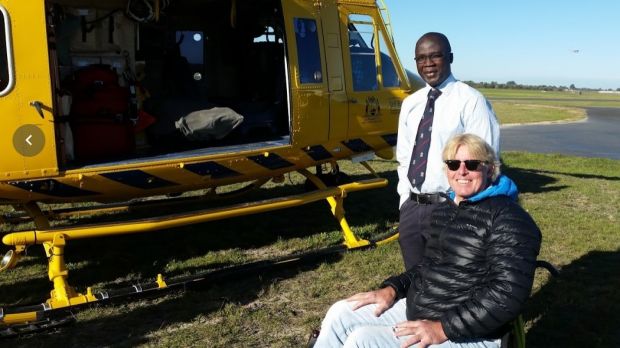A Perth doctor has found himself in the wrong place at the right time after he missed his turn-off while driving and moments later was performing life-saving surgery without any anaesthetic on a man dying on the side of the road.
Royal Perth Hospital senior registrar Edward Yeboah was travelling along Great Ocean Drive in Yanchep when he realised he had missed the turn-off to a mango farm he had planned to visit.

He decided to continue heading north until it was safe to turn around when he came across a head-on truck collision which must have had happened just minutes earlier.
“It was very confronting… one of the trucks was completely smashed, the dashboard had caved in and the driver’s face was smashed,” he said.

“I pulled over and I had my ID card in my car so I quickly identified myself as a doctor.”
With truck driver Simon Treloar trapped inside his vehicle, Dr Yeboah rang the head of Royal Perth Hospital’s trauma unit, Dr Sudhakar Rao, to send help.
“The fire-fighters and ambulance arrived, so then I just stepped back to allow them to do their work,” Dr Yeboah said.
“They were cutting him out of the car, it took roughly two or three hours.
“He had a collapsed lung, he had facial injuries, fractures on both legs, and a laceration on his right upper arm.”
Emergency services asked Dr Yeboah, a trainee surgeon, to stay at the site in case they needed him.
Not long after Mr Treloar was freed from his vehicle, a paramedic shouted out for help.
“[The paramedic] had put a needle into his chest to try and decompress his chest, which didn’t work, and he was deteriorating quite quickly, so I just made a decision then to cut a hole in the side of his chest to let out the air,” Dr Yeboah.
“I told him, look I have to cut open your chest, you can’t wait for local anaesthetic, we don’t have time, and he said, ‘yeah, just go for it mate’.
“It was probably three centimetres I cut through the side of the chest, right into the chest cavity. Then I put my finger in, stretched it out and let out the gas.
“I’m sure it did hurt, but that was the circumstances.”
Mr Treloar stabilised soon after, but then crashed again, with Dr Yeboah having to reopen the wound once more to release the air from his lungs, all while Dr Rao was on the phone assisting him through the procedure.
“[The procedure] is something I’ve done before several times, it’s the first thing you do before you put in a chest tube,” he said.
Mr Treloar and Dr Yeboah reunited, along with the paramedics and fire fighters who helped save Mr Treloar, five months later in June.
Mr Treloar is still in a wheelchair but is expected to walk again soon.
“He had a difficult recovery in ICU and he had a prolonged stay and had to go to theatre quite a few times, but he’s otherwise been recovering well,” Dr Yeboah said.
“He tells me I saved his life and he’s forever indebted to me, but I think most people in the same circumstance, who had the skill, would have done the same thing.”
